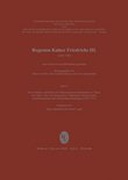Explore

Regesten Kaiser Friedrichs des Dritten (1440-1493)
Daniel Luger and Sonja Dünnebeil
2012
Als Folge des Todes von Herzog Karl dem Kühnen von Burgund und der Ehe seiner einzigen Tochter Maria mit Maximilian, dem Erben Kaiser Friedrichs III., wurden die wirtschaftlich und kulturell prosperierenden Länder Flandern und Brabant Teil der habsburgischen Erblande, wodurch die Basis für den Aufstieg des Hauses Habsburg zur europäischen Großmacht begründet wurde. Dieses dynastische Projekt stand mit wechselndem Erfolg für etwa 10 Jahre (1467-1477) im Mittelpunkt der diplomatischen Bemühungen Kaiser Friedrichs III. Zahlreiche Quellen zu diesen Verhandlungen werden im ehemaligen habsburgischen Hausarchiv, dem heutigen Haus-, Hof- und Staatsarchiv zu Wien aufbewahrt. Bislang wurden lediglich Dokumente bis zum Jahr 1469 im Rahmen der "Regesta Imperii - Regesten Kaiser Friedrichs III." veröffentlicht. Die vorliegende Publikation setzt dieses systematische Sammlung und Regestierung von Urkunden und Briefen dieses bedeutenden Kaisers bis zum Jahr 1475 fort. Als grundlegende Quellenedition legt sie die Basis für weitere Forschungsfragen zum späten Mittelalter. So bietet das vorgelegte Material unter anderem Grundlagen zu Forschungen auf dem Gebiet der politischen Kommunikation im Spätmittelalter, so etwa für Studien zu den Beziehungen zwischen Kaiser Friedrich III. und Herzog Karl von Burgund. Das Material kann etwa als Basis für eine Untersuchung zu den Differenzen und Ähnlichkeiten der Diplomatie zweier unterschiedlich entwickelten Kultursphären des spätmittelalterlichen Europas dienen. Daneben bietet die formale und inhaltliche Analyse von diplomatischen Schreiben Informationen zu den unterschiedlichen Medien der diplomatischen Kommunikation, über Ziele, Möglichkeiten und Erfolg von diplomatischen Bemühungen. Eine Analyse der in den Quellen genannten, handelnden Personen erhellt die institutionelle Struktur, welche die Entwicklung von Netzwerken aristokratischer, bürgerlicher und rechtskundiger Eliten ermöglichte. Ein weiterer Schwerpunkt des Quellenmaterials bildet die landesfürstliche Aktivität Kaiser Friedrichs III., besonders in den Jahren 1470 bis 1473, in denen sich der Kaiser vorrangig in seinen Erblanden aufhielt und dort mit zahlreichen Konfliktfeldern konfrontiert war, die in den Regesten deutlich werden. Friedrichs Definition seiner Stellung als Haupt des Hauses Habsburg wird im Zuge der diplomatischen Beziehungen zu seinem Vetter Sigmund verdeutlicht. Neben vielen weiteren Themen tritt auch Friedrichs Funktion als oberster Gerichtsherr des Reiches in den Quellen zu Tage. Hier sind vor allem zahlreiche richterliche Ladungen und Urteile des Kammergerichts zu nennen, welches in dem behandelten Zeitraum an Erzbischof Adolf von Mainz verpfändet war.
This book is included in DOAB.
Why read this book? Have your say.
You must be logged in to comment.
